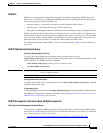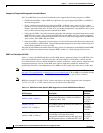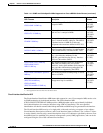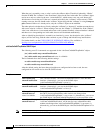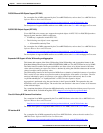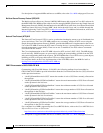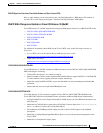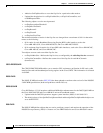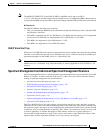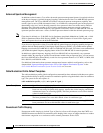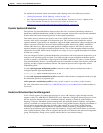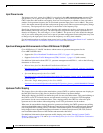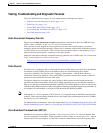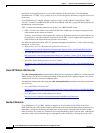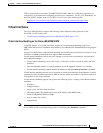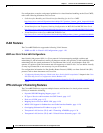
1-119
Cisco uBR7200 Series Universal Broadband Router Software Configuration Guide
OL-2239-05
Chapter1 Overview of Cisco uBR7200 Series Software
cops tcp window-size
Note The MODULE-IDENTITY for the DSG-IF-MIB is dsgIfMib, and its top-level OID is
1.3.6.1.4.1.9.9.999 (iso.org.dod.internet.private.enterprises.cisco.ciscoMgmt.dsgIfMib). Because this is
an experimental MIB, its top-level OID is expected to change when the DSG specifications are finalized.
MIB Constraints
The DSG-IF-MIB has the following constraints:
• This is an experimental MIB that can be obsoleted and replaced without prior notice, when the DSG
specification is finalized.
• This MIB is supported only in Cisco IOS Release 12.3(9a)BC and later releases. It is not supported
for the version of DSG that was implemented in Cisco IOS Release 12.2(15)BC1.
• This MIB is not supported in Cisco IOS Release 12.1 EC.
• This MIB is not supported on Cisco uBR7100 routers.
SNMP Warm Start Trap
When two Cisco uBR7200 series routers are configured for failover and the active unit fails, the standby
unit takes over and becomes the active unit. Whenever this occurs, a Failover Switchover SNMP trap is
generated and appears to the SNMP server as a “Warm Start” trap.
Note When a Cisco uBR7200 series router is powered up, an SNMP trap is generated and appears to the
SNMP server as a “Cold Start” trap. This functionality is already supported in all Cisco IOS 12.1 EC
releases.
Spectrum Management and Advanced Spectrum Management Features
Spectrum management features, including dynamic upstream modulation were introduced in Cisco IOS
Release 12.2(4)XF1, and these continue in the Cisco 12.2 BC release train. These and other features
relating to spectrum management are described below:
• Advanced Spectrum Management, page 1-120
• Cable Modulation Profile Default Templates, page 1-120
• Downstream Traffic Shaping, page 1-120
• Dynamic Upstream Modulation, page 1-121
• Guided and Scheduled Spectrum Management, page 1-121
• Input Power Levels, page 1-122
• Spectrum Management Enhancements in Cisco IOS Release 12.3(9a)BC, page 1-122
• Upstream Traffic Shaping, page 1-122
The Cisco uBR7200 Series line cards support varying options that allow service providers to specify
different rules the system uses when encountering noise on the cable plant. The primary problem with
the upstream system is the ingress of noise, both long-term interference from RF sources such as CB and
commercial services, and degradation of the HFC plant. There is also short term sources of noise such
as electric appliances or switches that appear a finite number of times for a typical duration of 1
microsecond in length and then go away. These various noise sources affect the Bit Error Rate of the
upstream data, and can impact the reliability of two-way services on the plant.



